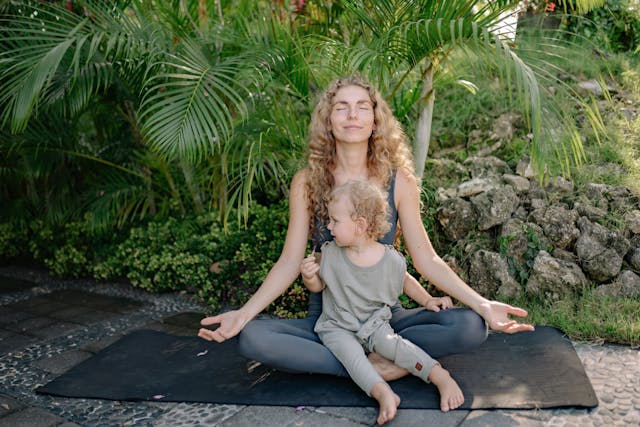Stress and tension have become ubiquitous in today’s fast-paced world. Whether it’s due to work pressures, personal issues, or the constant barrage of information from the digital world, maintaining mental health can be challenging. Fortunately, practices like mindfulness and meditation offer powerful tools to manage stress and enhance overall well-being. We are going to explore the benefits of mindfulness and meditation, their historical origins, and how they can support mental health.
Understanding Mindfulness and Meditation
Mindfulness is the practice of being fully present and engaged in the current moment, aware of your thoughts, feelings, and surroundings without judgment. It’s about experiencing the present without distraction or preoccupation. Meditation, on the other hand, is a broader category of practices that involve training the mind to focus and achieve a state of calm and clarity. While meditation often includes mindfulness, it also encompasses other techniques aimed at achieving specific outcomes, such as relaxation, concentration, or spiritual growth.

Historical Context
The origins of mindfulness and meditation are deeply rooted in ancient traditions, primarily from Eastern cultures. Mindfulness as a practice can be traced back to Buddhism, particularly within the teachings of Siddhartha Gautama, the Buddha, around the 5th century BCE. The Buddha taught mindfulness (known as ‘sati’ in Pali) as a part of the Noble Eightfold Path, which is a guide to end suffering and achieve enlightenment.
Meditation also has ancient origins, appearing in various forms across different cultures and religions. In Hinduism, meditation practices like Dhyana are described in ancient texts such as the Vedas and the Upanishads, dating back to 1500 BCE. Similarly, meditation is integral to the practice of Yoga, which aims to unite the mind, body, and spirit.
In Taoism, which emerged in China around the 4th century BCE, meditation is used to align oneself with the Tao, or the fundamental nature of the universe. The practice involves sitting quietly, breathing deeply, and allowing thoughts to come and go without attachment.

The Benefits of Mindfulness and Meditation
Mindfulness and meditation have profound effects on mental health. Numerous studies have shown that these practices can reduce symptoms of depression, anxiety, and post-traumatic stress disorder (PTSD). For instance, a meta-analysis published in the journal JAMA Internal Medicine found that mindfulness meditation programs can help improve symptoms of anxiety, depression, and pain.
The mechanism behind these benefits involves changes in brain structure and function. Regular meditation has been shown to increase the thickness of the prefrontal cortex, which is responsible for executive functions such as decision-making, attention, and self-control. It also reduces the size of the amygdala, the brain’s fear center, leading to a decrease in stress and anxiety levels.
One of the most well-known benefits of mindfulness and meditation is their ability to reduce stress. When we experience stress, our bodies release cortisol, the stress hormone. Chronic stress leads to sustained high levels of cortisol, which can have detrimental effects on the body and mind, including immune suppression, increased blood pressure, and cognitive impairments.
Mindfulness meditation has been shown to lower cortisol levels, thereby reducing stress. This is achieved through the activation of the body’s relaxation response, a state of deep rest that counteracts the stress response. A study published in Health Psychology found that participants who practiced mindfulness meditation showed a significant reduction in cortisol compared to those who did not.
Emotional regulation refers to the ability to manage and respond to emotional experiences in a healthy way. Mindfulness and meditation enhance emotional regulation by increasing awareness of emotional states and providing tools to respond to them non-reactively. This can be particularly beneficial for individuals with mood disorders or those experiencing high levels of emotional stress.
Research published in the journal Psychological Science found that mindfulness training can improve emotional regulation by decreasing emotional reactivity and increasing cognitive flexibility. This allows individuals to respond to emotional challenges with greater equanimity and resilience.

The Science Behind Mindfulness and Meditation
Recent advances in neuroscience have provided valuable insights into how mindfulness and meditation affect the brain. Functional magnetic resonance imaging (fMRI) studies have shown that these practices can lead to structural changes in the brain, a phenomenon known as neuroplasticity.
Regular meditation has been associated with increased gray matter density in brain regions involved in learning, memory, and emotional regulation, such as the hippocampus and the prefrontal cortex. Conversely, it has been shown to decrease gray matter density in the amygdala, which is involved in fear and stress responses.
A study conducted by Harvard researchers and published in Psychiatry Research: Neuroimaging found that an eight-week mindfulness meditation program resulted in measurable changes in brain regions associated with memory, sense of self, empathy, and stress.
Mindfulness and meditation also enhance the connectivity between different brain regions, leading to improved cognitive functions such as attention, memory, and executive function. These changes are particularly evident in the default mode network (DMN), a network of brain regions involved in self-referential thinking and mind-wandering.
A study published in Proceedings of the National Academy of Sciences found that experienced meditators showed decreased activity in the DMN, which is associated with a reduction in mind-wandering and self-referential thoughts. This suggests that mindfulness and meditation can help individuals stay focused on the present moment, reducing rumination and enhancing overall mental clarity.

Practical Applications of Mindfulness and Meditation
Given the numerous benefits of mindfulness and meditation, incorporating these practices into daily life can significantly enhance mental health and well-being. Here are some practical ways to get started:
Mindfulness Meditation
Mindfulness meditation involves focusing on the breath and bringing attention to the present moment. Here’s a simple way to practice:
- Find a quiet place: Sit comfortably with your back straight and hands resting on your lap.
- Close your eyes: Take a few deep breaths to relax.
- Focus on your breath: Notice the sensation of your breath as it enters and leaves your nostrils or the rise and fall of your abdomen.
- Be present: If your mind wanders, gently bring your attention back to your breath without judgment.
- Practice regularly: Start with a few minutes each day and gradually increase the duration.
Body Scan Meditation
Body scan meditation involves paying attention to different parts of the body, one at a time, to cultivate awareness and relaxation. Here’s how to do it:
- Lie down comfortably: Close your eyes and take a few deep breaths.
- Focus on each body part: Start from the top of your head and slowly move down to your toes, noticing any sensations, tension, or discomfort.
- Release tension: As you focus on each body part, imagine releasing any tension or stress you may feel.
- Stay present: If your mind wanders, gently bring your attention back to the body part you’re focusing on.
- Practice regularly: Aim for a few minutes each day to start.
Loving-Kindness Meditation
Loving-kindness meditation involves focusing on developing feelings of compassion and love towards oneself and others. Here’s a simple way to practice:
- Find a quiet place: Sit comfortably with your back straight and hands resting on your lap.
- Close your eyes: Take a few deep breaths to relax.
- Generate feelings of love and compassion: Start by focusing on yourself and repeating phrases like “May I be happy, may I be healthy, may I be safe, may I live with ease.”
- Extend these feelings to others: Gradually extend these feelings to loved ones, friends, acquaintances, and even those you have conflicts with.
- Practice regularly: Aim for a few minutes each day to start.

The Global Impact of Mindfulness and Meditation
Mindfulness and meditation have transcended cultural and geographical boundaries, becoming global phenomena embraced by people from all walks of life. This widespread adoption is a testament to their universal appeal and effectiveness in promoting mental health and well-being.
In the 20th century, mindfulness and meditation gained significant attention in the West, largely due to the efforts of pioneers like Jon Kabat-Zinn, who developed the Mindfulness-Based Stress Reduction (MBSR) program. MBSR has been extensively researched and validated as an effective intervention for reducing stress, anxiety, and depression.
Today, mindfulness and meditation are integrated into various healthcare settings, including hospitals, clinics, and therapeutic practices. Programs like MBSR and Mindfulness-Based Cognitive Therapy (MBCT) are used to treat conditions such as chronic pain, PTSD, and substance abuse.
The benefits of mindfulness and meditation have also been recognized in corporate and educational settings. Companies like Google, Apple, and Microsoft offer mindfulness programs to their employees to enhance productivity, creativity, and overall well-being. In schools, mindfulness programs are being implemented to help students manage stress, improve focus, and enhance emotional regulation.
Headspace – link to relaxation app
Calm – link to relaxation app

Conclusion
Mindfulness and meditation offer powerful tools for enhancing mental health, reducing stress, and improving overall well-being. Their ancient roots and contemporary scientific validation make them accessible and effective practices for people from all walks of life. By incorporating mindfulness and meditation into daily routines, individuals can experience profound transformations in their mental, emotional, and physical health.
Whether you’re new to mindfulness and meditation or looking to deepen your practice, there are numerous resources available to support you on your journey. Books, online courses, and guided meditation apps can provide valuable guidance and inspiration. As you embark on this path, remember that mindfulness and meditation are not about achieving perfection but about embracing the present moment with kindness and curiosity.
By cultivating mindfulness and meditation, you can create a foundation of inner peace and resilience, enabling you to navigate life’s challenges with greater ease and grace. The journey towards mental health and well-being is a lifelong one, and mindfulness and meditation are invaluable companions along the way.
Exploring the wealth of knowledge and experiences available, you can make mindfulness and meditation integral parts of your life, reaping the myriad benefits they offer. Embrace this journey with an open heart and mind, and discover the profound peace and clarity that mindfulness and meditation can bring.
Browse Nomadify’s website to learn about coping strategies and alternative therapies that may interest you.
Find below links to mental health support services in the UK and USA.
https://firstchoiceservices.org (USA)
Crisis services and planning – Mental health (UK)
Love Life x
References
- Kabat-Zinn, J. (1990). Full Catastrophe Living: Using the Wisdom of Your Body and Mind to Face Stress, Pain, and Illness. Delta.
- Goleman, D. (1988). The Meditative Mind: The Varieties of Meditative Experience. TarcherPerigee.
- Baer, R. A. (2003). Mindfulness training as a clinical intervention: A conceptual and empirical review. Clinical Psychology: Science and Practice, 10(2), 125-143.
- Segal, Z. V., Williams, J. M. G., & Teasdale, J. D. (2002). Mindfulness-Based Cognitive Therapy for Depression: A New Approach to Preventing Relapse. Guilford Press.
- Davidson, R. J., & McEwen, B. S. (2012). Social influences on neuroplasticity: Stress and interventions to promote well-being. Nature Neuroscience, 15(5), 689-695.
- Chiesa, A., & Serretti, A. (2010). A systematic review of neurobiological and clinical features of mindfulness meditations. Psychological Medicine, 40(8), 1239-1252.
- Hölzel, B. K., Carmody, J., Vangel, M., Congleton, C., Yerramsetti, S. M., Gard, T., & Lazar, S. W. (2011). Mindfulness practice leads to increases in regional brain gray matter density. Psychiatry Research: Neuroimaging, 191(1), 36-43.
- Kabat-Zinn, J. (2013). Mindfulness for Beginners: Reclaiming the Present Moment—and Your Life. Sounds True.
- Ricard, M. (2003). Happiness: A Guide to Developing Life’s Most Important Skill. Little, Brown and Company.
- Lutz, A., Slagter, H. A., Dunne, J. D., & Davidson, R. J. (2008). Attention regulation and monitoring in meditation. Trends in Cognitive Sciences, 12(4), 163-169.

